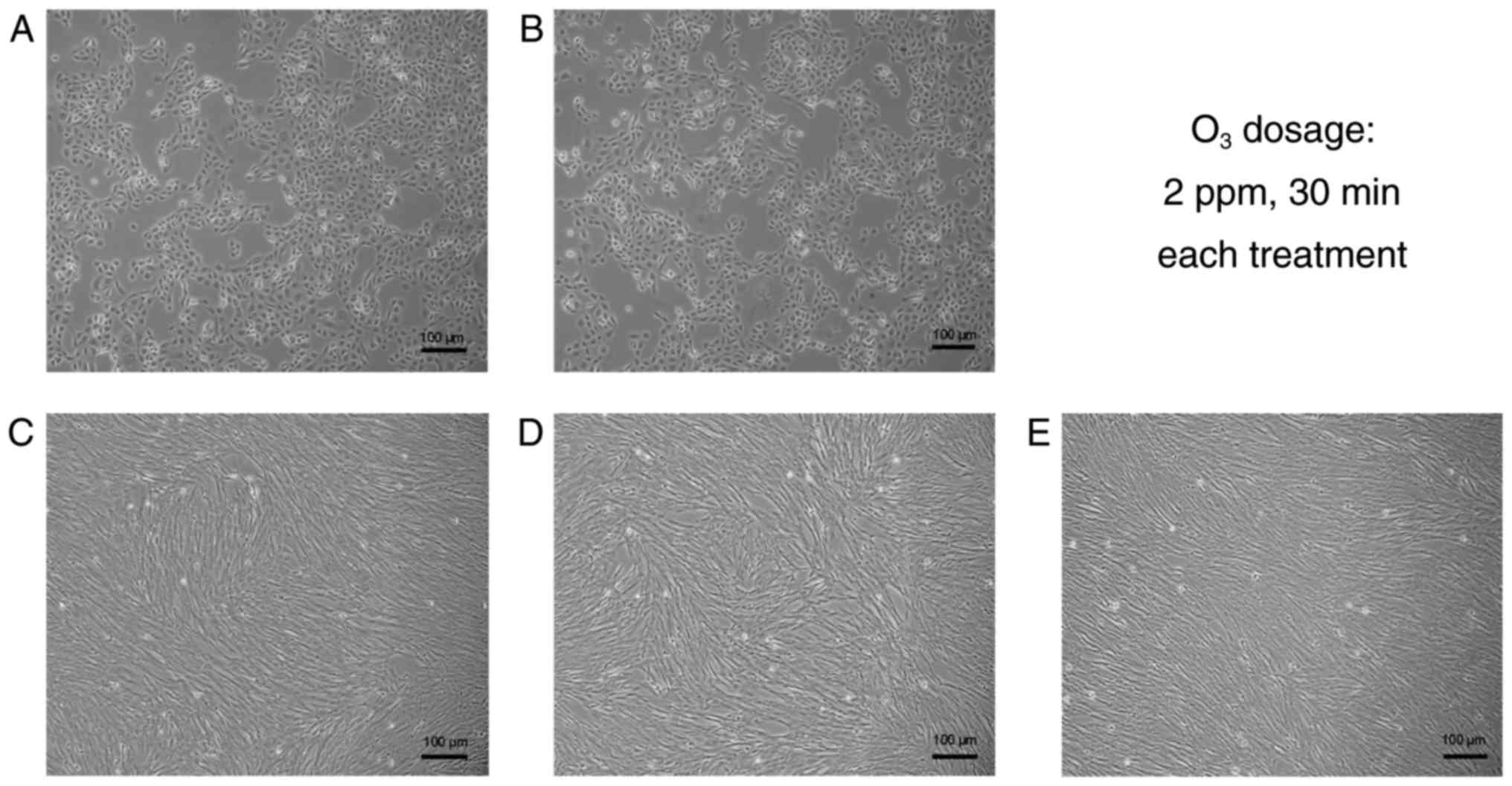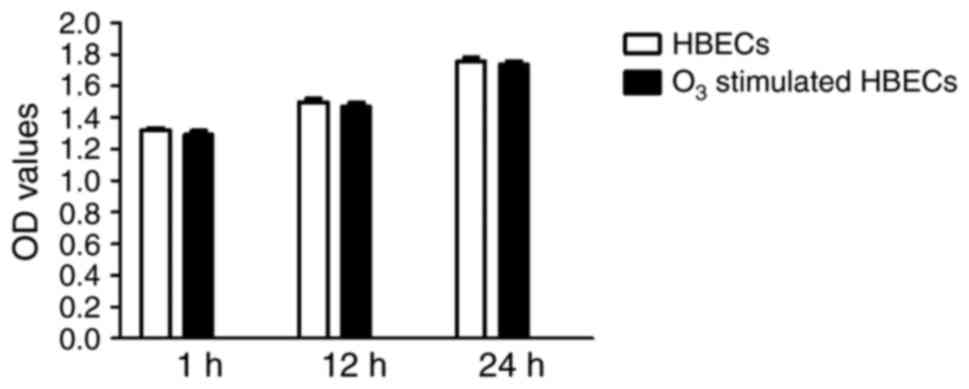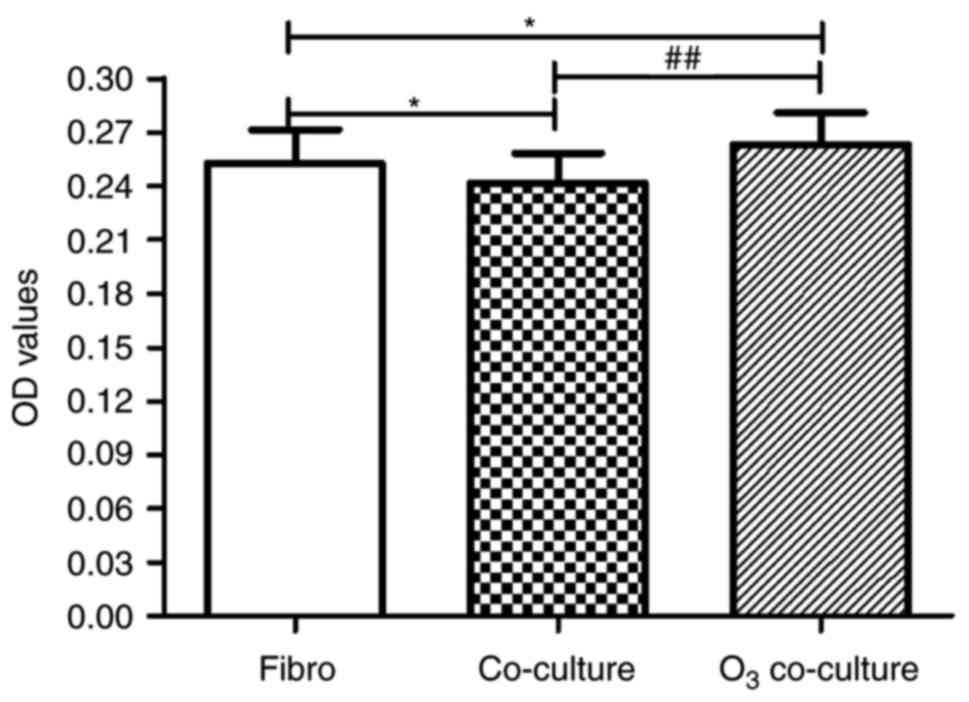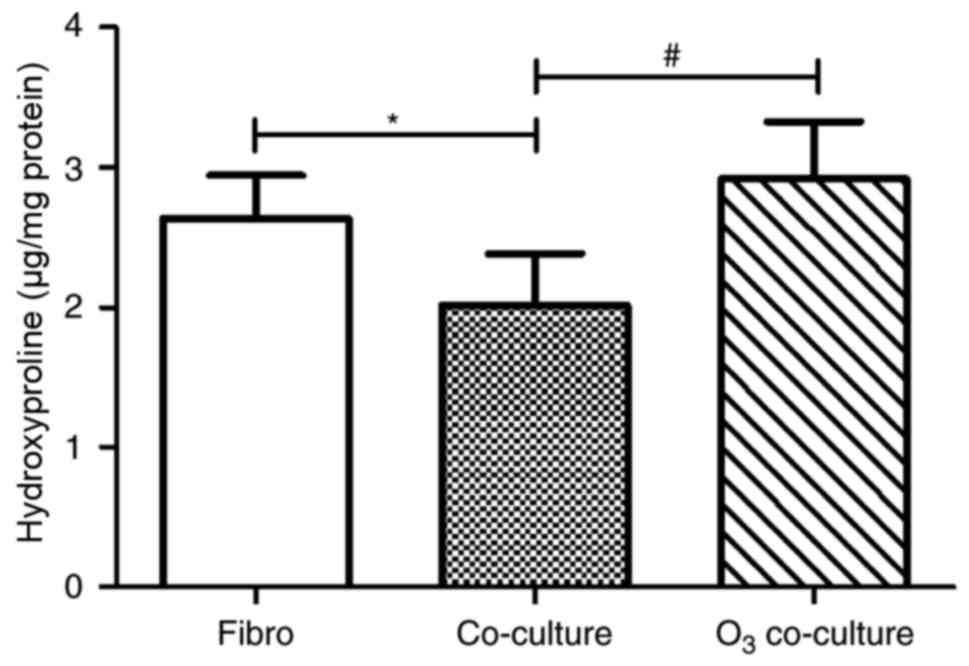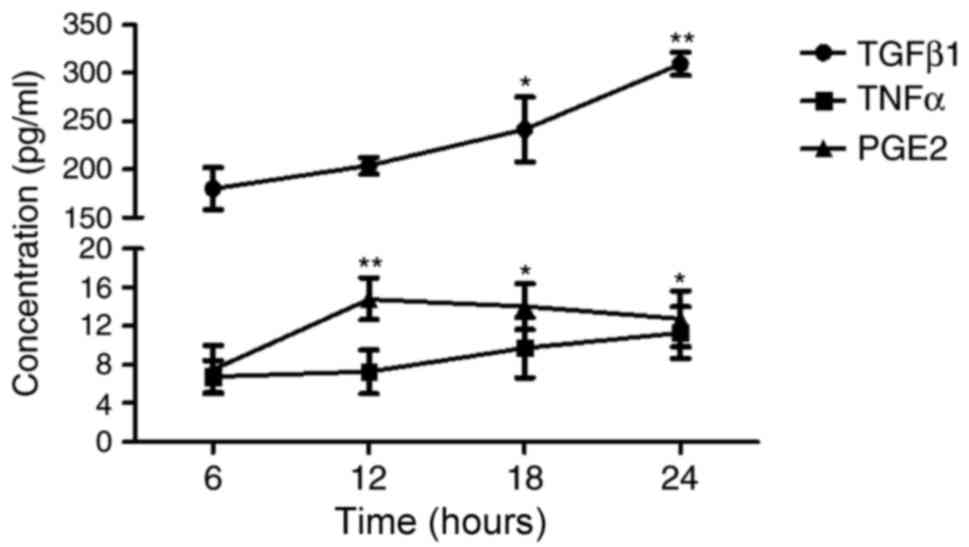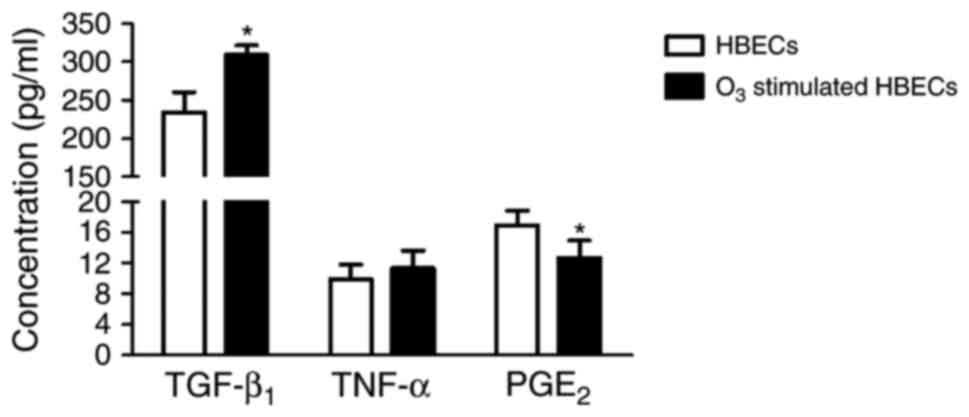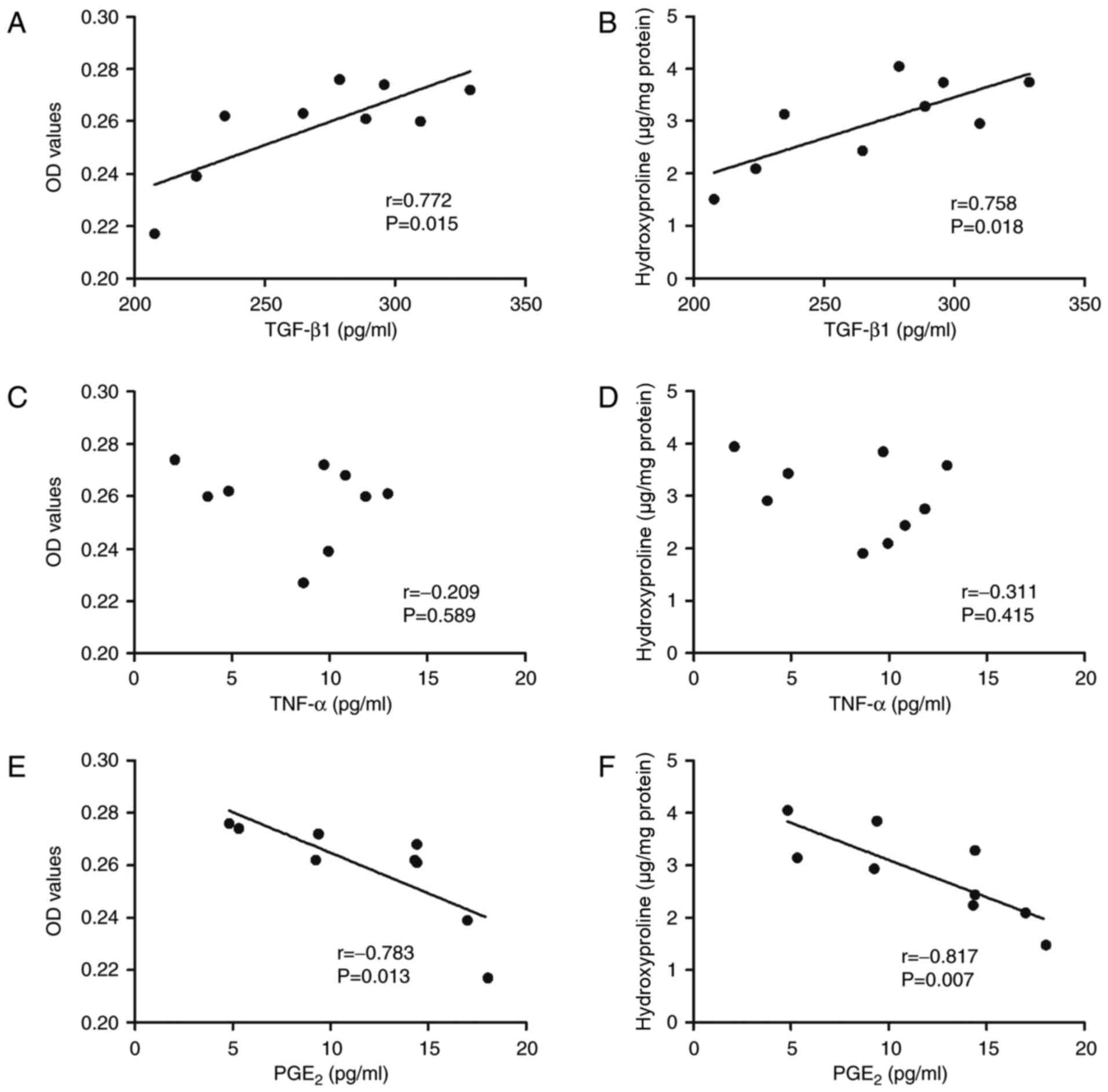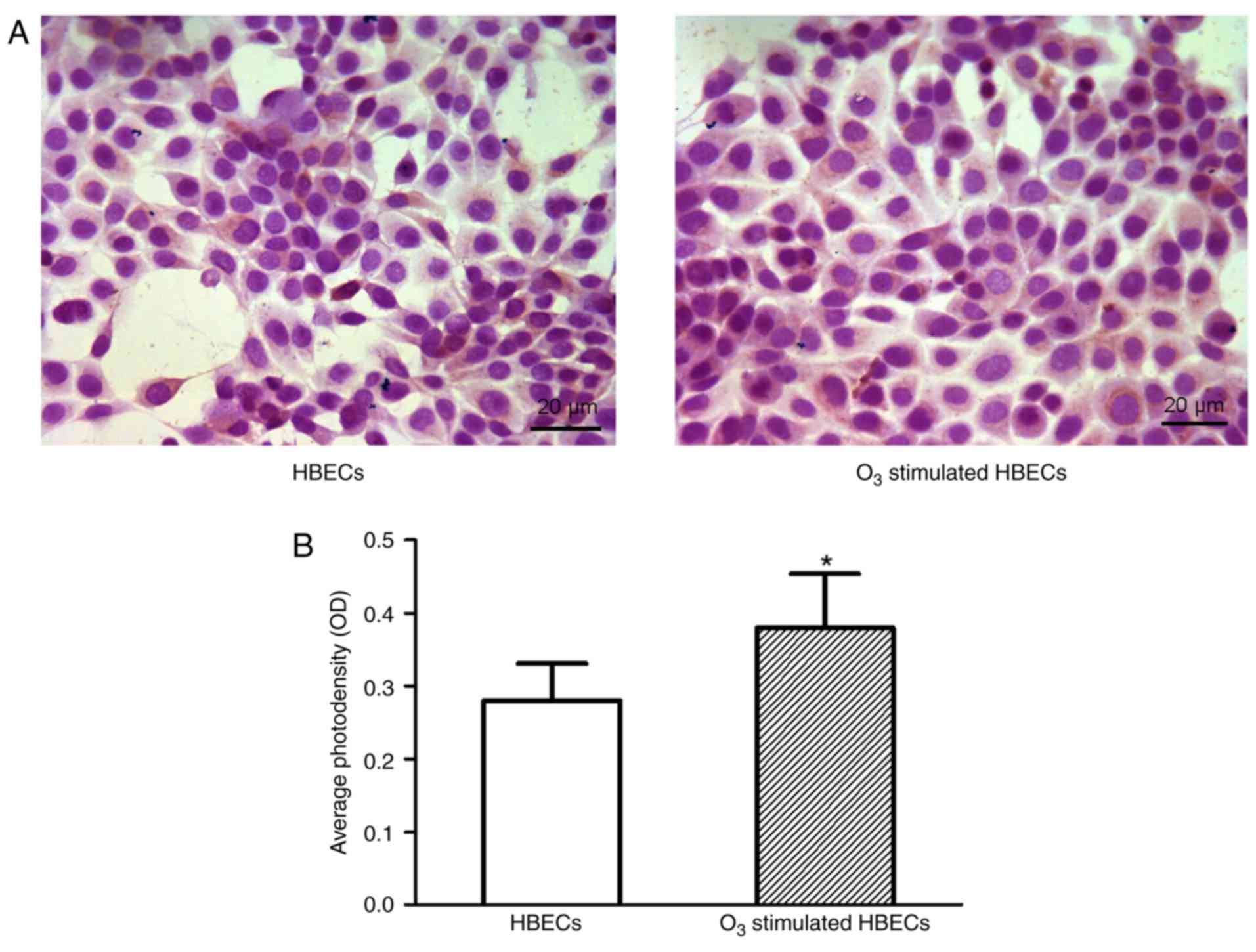Effects of ozone stimulation of bronchial epithelial cells on proliferation and collagen synthesis of co‑cultured lung fibroblasts
- Authors:
- Published online on: May 2, 2018 https://doi.org/10.3892/etm.2018.6122
- Pages: 5314-5322
-
Copyright: © Wang et al. This is an open access article distributed under the terms of Creative Commons Attribution License.
Abstract
Introduction
Bronchial asthma is a chronic airway inflammatory disease mediated by a variety of cell types and factors (1). A key hallmark associated with bronchial asthma is marked airway remodeling, which at tissue and cellular levels primarily includes airway wall thickening, airway epithelial fibrosis, airway smooth muscle cell hyperplasia and hypertrophy and myofibroblast proliferation and activation (2). At a molecular level, the pathological changes of airway remodeling are known to be associated with increased deposition of extracellular matrix (ECM) components, including type I, III and IV collagen fibers and fibronectin (3–5). Although the underlying mechanism of airway remodeling is not fully understood, it is generally acknowledged that airway remodeling is predominantly a result of the imbalance of airway injury and repair following repeated airway injury from chronic exposure to hazardous environmental factors and abnormal repair due to chronic airway inflammation (2). This association between airway remodeling and environmental hazards may be a contributing factor to the rising incidence of bronchial asthma, particularly in industrial countries worldwide during recent decades; the highest prevalence of clinical asthma worldwide were reported in Australia, Sweden, UK, Netherlands and Brazil were 21.5, 20.2, 18.2, 15.3 and 13.0%, respectively (6).
Among the environmental hazardous factors known to cause adverse effects on health, ozone (O3) is a major factor in air pollution, which is widely recognized as a particularly harmful risk to airway health (7,8). In human and animal studies, it has been demonstrated that early exposure at post-natal stage or long-term exposure at later stages to O3 may result in pathological changes in the respiratory system, including modifications of time and mode of alveolar growth and development (9,10). It has been reported that O3 exposure may also cause inflammation in the airways and the lungs and structural reorganization of smooth muscle cells (11,12). Previous studies indicated that O3 induced oxidative stress to airway epithelial cells cultured in vitro, resulting in the release of nitric oxide and epithelial cell injury (13), and that exposure to O3 of the bronchial epithelium resulted in airway inflammation and airway hyperresponsiveness (14,15).
Notably, there is little evidence to support whether O3 exposure may result in airway remodeling. The limited reports regarding this may partly be due to the fact that O3 directly targets bronchial epithelial cells (BECs) but not the fibroblasts that reside beneath these cells, which serve a key role in airway remodeling (16).
In order to explore the association between O3 exposure and airway remodeling, it was hypothesized that BECs exposed to O3 will release inflammatory growth factors, including transforming growth factor (TGF)-β1, which may subsequently enhance the secretion and activity of collagen from adjacent fibroblasts in the airway wall and ultimately result in airway remodeling. To investigate this hypothesis in the present study, a co-culture model of human lung fibroblasts (HLFs) and human bronchial epithelial cells (HBECs) was constructed. O3 stress was applied to the HBECs and cell proliferation and secretion of cytokines in the HLFs were assessed. The present study aimed to elucidate the mechanism of O3-induced airway remodeling from a novel perspective of maintenance/loss of steady-state function of the airway epithelium.
Materials and methods
HBE and HLF culture
HBECs from a cell line were provided by Professor Gruenent of University of California, San Francisco (San Francisco, USA) (17). Embryonic diploid HLF-02 HLFs were purchased from the Cell Center of Central South University (Changsha, China). HBECs were seeded in Dulbecco's modified Eagle medium (DMEM)/F12 (1:1 ratio; Hyclone, Logan, UT, USA) supplemented with 15% newborn calf serum (Gibco; Thermo Fisher Scientific, Inc., Waltham, MA, USA), 100 U/ml penicillin and 100 U/ml streptomycin in a 100-ml culture flask. Cells grew adherently at 37°C until 80% confluence was reached. Subsequently, the culture medium was displaced and the cells were rinsed with phosphate-buffered saline one to two times. Following this, HBECs were trypsinized with 1 ml 0.25% trypsin with 0.05% EDTA and scattered gently through a pipette to create the cell suspension. HBECs were divided in 1:2 or 1:3 proportions for subculture. When cells in subculture grew to 80% confluence with a healthy, cuboid morphology, they were seeded on culture plates for subsequent experiments. HLFs were cultured and prepared for experiments as described above.
Co-culture of HLFs and O3-stimulated HBECs
Prior to co-culture, confluent HBECs in subculture flasks were harvested by trypsinization and then counted manually using trypan blue (0.4%) staining to detect the live cells. HBECs were seeded onto coverslips that had been placed in 24-well culture plates (Thermo Fisher Scientific, Inc.) at 1×105 cells/ml (1 ml per well). Subsequently, the cells were cultured at 37°C and 5% CO2 for 48 h in DMEM medium supplemented with 15% newborn calf serum to allow the cells to adhere to the coverslip. After 48 h, the medium was replaced with DMEM supplemented with 1% newborn calf serum (Gibco; Thermo Fisher Scientific, Inc.).
To establish the O3 stimulated HBECs group, HBECs were prepared as above and were incubated in DMEM supplemented with 1% newborn calf serum for 8 h. Subsequently, HBECs were stimulated with O3 (2 ppm) for 30 min and incubated for 1 h prior to co-culture with HLFs. For the control (HBECs) group, the HBECs followed the same time course and procedure, with the exception that the HBECs were not exposed to O3 for 30 min.
HLFs were also harvested and counted as described above for HBECs. HLFs were seeded into the 24-well plates at 2×104 cells/ml (1 ml per well). HLFs were cultured in DMEM supplemented with 15% newborn calf serum for 12 h to allow the cells to adhere to the culture dish. The medium was replaced with DMEM supplemented with 1% newborn calf serum and cells were incubated for a further 12 h. Subsequently, a sterile stainless steel screen mesh was inserted into each well containing the HLFs and a coverslip with HBECs that had been stimulated or not simulated with O3 was placed on top of the stainless steel screen mesh that provided separation between the HBECs and HLFs in the same well. HBECs and HLFs were co-cultured in the same well for 24 h. following this, the coverslip and the mesh were removed from the well, respectively, and the proliferation of HLFs was assessed by MTT colorimetric method.
MTT colorimetry for evaluation of cell proliferation
The proliferation of HLFs was evaluated using the MTT colorimetric method. HLFs were divided into the following three groups: Fibro group, which contained HLFs that had been cultured alone; co-culture group, which contained HLFs co-cultured with HBECs without O3 stimulation; and O3 co-culture group, which contained HLFs co-cultured with O3-stimulated HBECs. Cells were seeded at 2×104 cells/ml (1 ml/well) in 24-well plates and treated with 100 µl of 0.5% MTT solution. Cells were incubated at 37°C for 4 h and the supernatant was removed. A total of 800 µl dimethyl sulfoxide was added to each well followed by 10 min steady oscillation of the 24-well plates. The cell suspension was aliquoted into 96-well plates and was analyzed using an automatic microplate reader (Elx800, Thermo Fisher Scientific, Inc., Waltham, MA, USA) at 570 nm. Culture medium without cells served as a blank control. Each experiment was repeated six times.
The proliferation of HBECs in the O3 stimulated and control groups was assessed as described above. The proliferation of HBECs was measured at 1, 12 and 24 h. Each measurement was repeated four times.
Assessment of HLF collagen synthesis
Collagen synthesis in HLFs was determined by assessing the hydroxyproline levels in HLF culture medium supernatant using a hydroxyproline kit (cat. no. A030-1; Nanjing Jiancheng Bioengineering Institute, Nanjing, China) according to the manufacturer's instructions. Hydroxyproline is a major component of collagen (18). Therefore, measurement of hydroxyproline levels in cell culture medium indicates the ability of the cell to produce collagen (18–21). To Pleameasure the hydroxyproline levels in the culture medium supernatant, 0.5 ml of culture medium was combined with 1 ml hydrolysate and hydrolyzed for 20 min in a boiling water bath (pH 6.0–6.8). A blank tube with distilled water, a standard tube with 5 µg/ml standard solution and a measurement tube with the hydrolyzed supernatant of culture medium were prepared, respectively. Subsequently, a 1-ml sample was taken from each tube and mixed with reagent One. Following 10 min standing at room temperature, each sample was mixed with reagent Two and left to stand for 5 min at room temperature. Following this, the sample was mixed with reagent Three, incubated at 60°C for 15 min, cooled and centrifuged at 4°C, 2,054 × g for 10 min. The absorbance of the supernatant was measured at 550 nm. Each tube was repeatedly measured four times. Total protein was assayed using the Lowry protein assay (22). Hydroxyproline levels were calculated as follows: Hydroxyproline (µg/mg protein)=[optical density (OD) of test tube/OD of standard sample tube]x(concentration of standard sample/total protein).
Detection of TGF-β1, TNF-α and PGE2 concentration in the supernatant of the co-cultured system and HBECs cultured alone
The concentration of inflammatory mediators TGF-β1 and TNF-α in the supernatant of O3-stimulated HBECs co-cultured with HLFs was assessed at 6, 12, 18 and 24 h following co-culture using ELISA kits (cat. no. MM-0090H1 and MM-0122H1, respectively; Jingmei Bioengineering Co., Ltd., Yancheng, China) according to the manufacturer's protocol. The OD value measured at 450 nm was directly proportional to the concentration of the indicator. By constructing a standard curve, the concentration of TGF-β1 and TNF-α in the specimen could be determined accordingly. The concentration of the inflammatory mediator PGE2 in the supernatant of the co-cultured system was measured using a PGE2 radioimmunoassay kit (cat. no. ADI-905-025-1; Enzo Life Sciences, Inc., Farmingdale, NY, USA) according to the manufacturer's protocol. The concentration of PGE2 in the sample was directly calculated using an automatic γ immuno-counter. The TGF-β1, TNF-α and PGE2 concentration was detected in the supernatant of O3-stimulated HBECs and HBECs cultured alone at 24 h as described above.
Detection of TGF-β1 protein expression levels in HBECs alone or co-cultured with HLFs
The protein expression levels of TGF-β1 in HBECs alone or co-cultured with HLFs were detected using an immunocytochemistry method. Cells were labeled for TGF-β1 expression using an immunocytochemistry staining kit (cat. no. SA1022; Wuhan Boster Biological Technology Ltd., Wuhan, China) according to the manufacturer's instructions. Cells were fixed with 95% alcohol at room temperature for 15 min and dipped in 30% H2O2 combined with 100% methanol (1:50 ratio) at room temperature for 30 min to block endogenous peroxidase activity. Cells were immersed in 5% bovine serum albumin blocking reagent at room temperature for 20 min. Following this, cells were treated with TGF-β1 antibodies (1:1,000; cat. no. BA0290) at 37°C for 1–2 h and biotinylated goat anti-rabbit IgG antibodies (1:500; cat. no. BA1003; both Wuhan Boster Biological Technology Ltd.) at room temperature for 20 min. Reagent SABC (Wuhan Boster Biological Technology Ltd.) was added at room temperature for 20 min. Cells were subsequently counterstained with hematoxylin at room temperature for 30 sec, dehydrated and observed under an optic microscope. For quantification of TGF-β1 expression in HBECs, images were captured of five randomly selected fields of view and analyzed using a medical image analysis and management system (MIAS version 4.1; Image Processing Center of Beihang University, Beijing, China) to assess the photodensity.
Statistical analysis
Data was presented as the mean ± standard deviation from the representative experiment. Each experiment was repeated four to six times. All data were processed using SPSS 21.0 software (IBM Corp., Armonk, NY, USA). An unpaired Student's t-test was performed to determine the statistical difference between two groups and multiple comparisons were determined using one-way analysis of variance followed by Dunnett's t-test. Correlations were analyzed using Pearson's correlation analysis method. P<0.05 was considered to indicate a statistically significant difference.
Results
Effect of O3 stimulation on cell morphology and proliferation
The morphology of HBECs and HLFs cultured alone or co-cultured with or without O3 stimulation was determined (Fig. 1). Results indicated the cells in culture demonstrated a normal shape and size individually (HBECs were cuboidal-like shape and HLFs were spindle-like shape) and were organized in usual structures collectively (HBECs were in a relatively uniform monolayer and HLFs were in a hill-valley-like formation), respectively. When the proliferation of HBECs was evaluated using the MTT method, the OD values were not significantly different between O3-stimulated HBECs and their non-stimulated counterparts when cultured for up to 24 h (P>0.05; Fig. 2). These results indicated that O3 stimulation had no marked effect on cell morphology regardless of the cell type and culture approach; furthermore, there was no significant effect on the cell proliferation of HBECs.
Co-culture with O3-stimulated HBECs enhances cell proliferation of HLFs
To investigate the cell proliferation of Fibro, Co-culture and O3 co-culture groups, the MTT assay was performed (Fig. 3). In comparison with the Fibro group, proliferation was significantly decreased in the Co-culture group (0.252±0.018 vs. 0.241±0.017, respectively; P<0.05), which indicated that co-culture conditions without O3 stimulation inhibited the proliferation of HLFs. However, cell proliferation of the O3 co-culture group was significantly increased compared with the Fibro group (0.263±0.017 vs. 0.252±0.018, respectively; P<0.05) and Co-culture group (0.263±0.017 vs. 0.241±0.017, respectively; P<0.01), respectively. These findings suggested that co-culture with O3-stimulated HBECs significantly enhanced the proliferation of HLFs when compared with HLFs cultured alone. Furthermore, co-culture with O3-stimulated HBECs significantly reversed the inhibition of HLF proliferation when co-cultured with HBECs that were not stimulated with O3.
Co-culture with O3-stimulated HBECs enhances collagen synthesis of HLFs
As indicated in Fig. 4, the effects on collagen synthesis of HLFs co-cultured with O3-stimulated HBECs were similar to those indicated for cell proliferation. Notably, the Co-culture group exhibited significantly decreased collagen synthesis-associated hydroxyproline levels compared with the Fibro group (2.014±0.366 vs. 2.634±0.310, respectively; P<0.05), which indicated that co-culture conditions without O3 stimulation reduced the collagen synthesis capacity of HLFs. However, the levels of hydroxyproline from the O3 co-culture group were significantly increased compared with the Co-culture group (2.919±0.407 vs. 2.014±0.366, respectively; P<0.05). These results also suggested that co-culture with O3-stimulated HBECs may reverse the inhibition of HLF collagen synthesis due to co-culture with HBECs that were not stimulated with O3.
Co-culture with O3-stimulated HBECs influences cytokine secretion in the supernatant of the co-culture system
The concentration of major cytokines, including TGF-β1, TNF-α and PGE2, in the supernatant of the co-culture system with O3-stimulated HBECs were assessed (Fig. 5). Results indicated that the concentration of TGF-β1 remained high and continuously increased over the 24 h after co-culture. TNF-α concentration remained low and did not significantly vary over the 24-h time period. Unlike TGF-β1, the concentration of PGE2 was significantly increased to the maximum at 12 h compared with 6 h (P<0.01) and plateaued thereafter. PGE2 concentration was significantly increased at 18 and 24 h compared with 6 h (P<0.05), but no significant difference was identified when compared with 12 h.
When compared with HBECs alone, the O3-stimulated HBECs cultured for 24 h exhibited significantly increased TGF-β1 concentration (234.80±25.55 vs. 309.47±12.22 pg/ml, respectively; P<0.05; Fig. 6). However, the concentration of PGE2 was significantly decreased in O3-stimulated HBECs compared with HBECs alone (12.74±2.19 vs. 16.97±1.92 pg/ml, respectively; P<0.05) and no significant difference was indicated in the concentration of TNF-α between the experimental groups (P>0.05).
Correlation between cytokine secretion and cell proliferation and collagen synthesis in HLFs
In order to investigate whether cell proliferation or collagen synthesis was associated with the secretion of cytokines when HLFs were co-cultured with O3-stimulated HBECs, correlation analysis between HLF proliferation and hydroxyproline levels and cytokine secretion was performed (Fig. 7). Results indicated a significant positive correlation between the secretion of TGF-β1 from the co-cultured system with O3-stimulated HBECs and cell proliferation (r=0.772, P=0.015) and collagen synthesis (r=0.758, P=0.018, Fig. 7A and B). Notably, no correlation was indicated between the cytokine secretion of TNF-α with cell proliferation or collagen synthesis of HLFs when co-cultured with O3-stimulated HBECs (Fig. 7C and D). However, a significant negative correlation was indicated between the cytokine secretion of PGE2 and cell proliferation (r=−0.783, P=0.013) and collagen synthesis (r=−0.817, P=0.007) of HLFs co-cultured with O3-stimulated HBECs.
Effect of O3 stimulation on TGF-β1 expression in HBECs
Immunocytochemistry was conducted to investigate TGF-β1 expression levels in HBECs and quantitative expression analysis was performed (Fig. 8). Results indicated that the expression level of TGF-β1 in O3-stimulated HBECs cultured for 24 h was increased compared with HBECs alone (Fig. 8A). This difference was statistically significant (P<0.05; Fig. 8B). In the co-culture system of HBECs and HLFs, the expression level of TGF-β1 was similarly enhanced in the presence of O3-stimulated HBECs (data not shown).
Discussion
Damage to the bronchial epithelium destroys the integrity of airway structure and function, leading to instability of the local microenvironment and dysfunction of the airways. These are initiative events of multiple airway diseases, including asthma and bronchitis (23). Repeated airway injury and abnormal repair may cause chronic airway inflammation, which eventually results in airway remodeling, as characterized by the activation and proliferation of fibroblasts and accumulation of the ECM (24). As one of the major structural cells of the airway submucosa, lung fibroblasts are known to contribute to the formation of subepithelial fibrosis, increase airway responsiveness and promote airway remodeling (25–27). Furthermore, lung fibroblasts have been acknowledged as the primary cells that produce ECM proteins to form collagen fibers, elastic fibers and reticular fibers, which are downstream components of the airway remodeling process (28). Although the function of lung fibroblasts has been extensively studied, it is not clear whether stress induced on the bronchial epithelium from the external environment, including air pollutants, may influence the submucosal lung fibroblasts to contribute to pathological airway remodeling. A useful model to explore this effect is the use of O3 to stimulate the bronchial epithelium prior to examination of the cellular functions of adjacent fibroblasts not in direct contact of O3 (29). O3 is a common major component of air pollution and has been revealed in various studies to cause airway epithelial shedding, airway inflammation and airway hyperresponsiveness (16,30). Therefore, the aim of the present study was to co-culture HLFs with airway epithelial cells pre-stimulated with O3 and subsequently measure the functional changes, including collagen synthesis, of the fibroblasts. Results of the present study indicated that, although O3 stimulation seemed to cause no noticeable changes in cell morphology or proliferation of HBECs cultured for up to 24 h, functional changes in the co-culture system of O3-stimulated HBECs and HLFs were indicated. Specifically, in the co-culture group without O3 stimulation, the proliferation of HLFs was significantly inhibited. However, co-culture of HLFs with O3-stressed HBECs resulted in significantly enhanced HLF proliferation, indicating that O3 stimulation reversed co-culture-induced inhibition of cell proliferation. O3 stimulation on HBECs had a similar effect on the collagen synthesis capacity of the HLFs in the in vitro co-culture model. These results suggest that O3 stress on the airway epithelium may be associated with the pathogenesis of airway remodeling via its indirect effect on the submucosal structural cells, including the HLFs.
The bronchial epithelium is an important source of complex inflammatory mediators, including cytokines and chemokines (31). By secreting inflammatory mediators, HBECs may interact with interstitial fibroblasts and mediate the process of epithelial-mesenchymal transition or fibroblast-myofibroblast transition, therefore actively participating in asthmatic airway remodeling (32–34). In the present study, O3 exposure upregulated the concentration of TGF-β1 in the supernatant of the co-culture system persistently for up to 24 h. Furthermore, O3 stress also promoted TGF-β1 secretion in the HBEC supernatant and TGF-β1 expression in HBECs labeled by immunocytochemistry. In addition, correlation analysis suggested that O3-induced upregulation of TGF-β1 secretion was positively and linearly correlated with cell proliferation and collagen synthesis of HLFs co-cultured with O3-stimulated HBECs. These results indicated that the increased TGF-β1 content may serve a key role in the proliferation and collagen synthesis of HLFs in the co-culture system. Furthermore, it is acknowledged that TGF-β1 may promote differentiation of fibroblasts into myofibroblasts, which secrete collagen and growth factors, including endothelin 1 and vascular endothelial growth factor, and then further promote proliferation of smooth muscle cells and vascular endothelial cells (35,36). Notably, it has also been reported that TGF-β1 induces mesenchymal transition of bronchial epithelial cells and thus promotes airway remodeling in asthma (37). Additionally, damaged epithelial cells may extend and amplify remodeling signals into a deeper layer of the mucous membrane (38). Such communication between epithelial cells and mesenchymal cells during asthma has been termed as epithelial mesenchymal trophic unit reactivation (38).
The present study indicated a low concentration of TNF-α was identified in the supernatant of the co-culture system with or without O3 stimulation. TNF-α content was also not significantly correlated with HLF proliferation and collagen synthesis. However, the present study demonstrated that the synthesis of PGE2 in the co-culture system with O3-stressed HBECs was significantly increased during the early stage and plateaued from 12–24 h. However, the secretion of PGE2 in O3-stimulated HBECs was significantly reduced compared with HBECs alone. In addition, correlation analysis indicated a negative linear correlation of PGE2 content with HLF proliferation and collagen synthesis. Therefore, the present findings suggested the regulatory effect of O3-stressed HBECs on HLF activity was associated with reduced PGE2 content in the airway tissues. Notably, PGE2 is a lipid mediator that may be derived from cell membrane phospholipids via the cyclooxygenase signaling pathway of arachidonic acid metabolism (39). PGE2 released from HBECs has been reported to relax airway smooth muscles, reduce the sensitivity of smooth muscles to contractile medium, inhibit the proliferation of smooth muscle cells and fibroblast activity and enhance the tolerance of lung epithelial cells to injury factors (23). These findings suggest that PGE2 may act as a negative feedback factor to counteract O3-induced proliferation and airway remodeling processes.
In the present study, the fact that the HBECs without O3 stimulation in the co-culture system inhibited the proliferation of HLFs is conducive to maintaining the normal structure and function of the bronchial airways. However, co-culture with O3-stimulated HBECs with HLFs resulted in increased cell proliferation and collagen synthesis of the HLFs and increased secretion of TGF-β1. Considering the pro- and anti-inflammatory properties of TGF-β1 and PGE2 respectively, the present findings suggest that the possible mechanism involved in the effect of O3 stimulation on the co-culture system may lie in the system's ability to maintain balance between pro- and anti-inflammatory factors. Under physiological conditions, the expression of anti-inflammatory factors, including PGE2, may prevail in the system to inhibit the proliferation and collagen synthesis of fibroblasts via PGE2 receptor EP2 subtype binding and cAMP production, therefore maintaining the airway homeostasis (40,41). However, under a stressed state, such as with O3 stimulation, the expression of pro-inflammatory factors, including TGF-β1, may be increased in the system and result in enhanced cell proliferation and collagen synthesis of fibroblasts, which may primarily occur through the regulation of p21/Waf1 gene transcription factors and the cyclin E-associated kinase (42). This may ultimately result to chronic and permanent airway remodeling in vivo.
In conclusion, the present findings suggest that O3 stimulation of HBECs is a likely factor in promoting cell proliferation and collagen synthesis activity of HLFs via the regulation of pro- and/or anti-inflammatory cytokines, including TGF-β1 and PGE2. Such cellular and molecular functional associations between HBECs and HLFs in response to O3 stimulation may provide an important connection between air pollution and airway remodeling in diseases such as asthma.
Acknowledgements
The authors would like to thank Professor Xiaoqun Qin of Central South University (Changsha, China) for his valuable advice to the data analysis and manuscript drafting.
Funding
The present study was supported by the National Natural Science Foundation of China (grant no. 11532003).
Availability of data and materials
All data generated or analyzed during this study are included in this published article.
Authors' contributions
YW, HO and LD designed the study. YW and MT performed the experiments. YW, HO and LD wrote the manuscript.
Ethics approval and consent to participate
All experiments using in vitro cultured human bronchial epithelial cells and lung fibroblasts were approved by the Medical Ethics Committee of Changzhou University (Changzhou, China) according to Ethics Examination Methods on Human Related Biomedical Research issued by China's Health Ministry (approval ref. no. CCZUBME20150516YW).
Consent for publication
Not applicable.
Competing interests
The authors declare that they have no competing interests.
References
|
Busse WW: Inflammation in asthma: The cornerstone of the disease and target of therapy. J Allergy Clin Immunol. 102:S17–S22. 1998. View Article : Google Scholar : PubMed/NCBI | |
|
Boulet LP: Airway remodeling in asthma: Update on mechanisms and therapeutic approaches. Curr Opin Pulm Med. 24:56–62. 2018. View Article : Google Scholar : PubMed/NCBI | |
|
Dekkers BG, Maarsingh H, Meurs H and Gosens R: Airway structural components drive airway smooth muscle remodeling in asthma. Proc Am Thorac Soc. 6:683–692. 2009. View Article : Google Scholar : PubMed/NCBI | |
|
Burgess JK, Ceresa C, Johnson SR, Kanabar V, Moir LM, Nguyen TT, Oliver BG, Schuliga M and Ward J: Tissue and matrix influences on airway smooth muscle function. Pulm Pharmacol Ther. 22:379–387. 2009. View Article : Google Scholar : PubMed/NCBI | |
|
Vogel ER, Britt RD Jr, Faksh A, Kuipers I, Pandya H, Prakash YS, Martin RJ and Pabelick CM: Moderate hyperoxia induces extracellular matrix remodeling by human fetal airway smooth muscle cells. Pediatr Res. 81:376–383. 2017. View Article : Google Scholar : PubMed/NCBI | |
|
To T, Stanojevic S, Moores G, Gershon AS, Bateman ED, Cruz AA and Boulet LP: Global asthma prevalence in adults: Findings from the cross-sectional world health survey. BMC Public Health. 12:2042012. View Article : Google Scholar : PubMed/NCBI | |
|
Turner MC, Jerrett M, Pope CA III, Krewski D, Gapstur SM, Diver WR, Beckerman BS, Marshall JD, Su J, Crouse DL and Burnett RT: Long-term ozone exposure and mortality in a large prospective study. Am J Respir Crit Care Med. 193:1134–1142. 2016. View Article : Google Scholar : PubMed/NCBI | |
|
Berman JD, Fann N, Hollingsworth JW, Pinkerton KE, Rom WN, Szema AM, Breysse PN, White RH and Curriero FC: Health benefits from large-scale ozone reduction in the United States. Environ Health Perspect. 120:1404–1410. 2012. View Article : Google Scholar : PubMed/NCBI | |
|
Miller DB, Snow SJ, Henriquez A, Schladweiler MC, Ledbetter AD, Richards JE, Andrews DL and Kodavanti UP: Systemic metabolic derangement, pulmonary effects, and insulin insufficiency following subchronicozone exposure in rats. Toxicol Appl Pharmacol. 306:47–57. 2016. View Article : Google Scholar : PubMed/NCBI | |
|
Avdalovic MV, Tyler NK, Putney L, Nishio SJ, Quesenberry S, Singh PJ, Miller LA, Schelegle ES, Plopper CG, Vu T and Hyde DM: Ozone exposure during the early postnatal period alters the timing and pattern of alveolar growth and development in nonhuman primates. Anat Rec (Hoboken). 295:1707–1716. 2012. View Article : Google Scholar : PubMed/NCBI | |
|
Carey SA, Ballinger CA, Plopper CG, McDonald RJ, Bartolucci AA, Postlethwait EM and Harkema JR: Persistent rhinitis and epithelial remodeling induced by cyclic ozone exposure in the nasal airways of infant monkeys. Am J Physiol Lung Cell Mol Physiol. 300:L242–L254. 2011. View Article : Google Scholar : PubMed/NCBI | |
|
Wiegman CH, Michaeloudes C, Haji G, Narang P, Clarke CJ, Russell KE, Bao W, Pavlidis S, Barnes PJ, Kanerva J, et al: Oxidative stress-induced mitochondrial dysfunction drives inflammation and airway smooth muscle remodeling in patients with chronic obstructive pulmonary disease. J Allergy Clin Immunol. 136:769–780. 2015. View Article : Google Scholar : PubMed/NCBI | |
|
Qin XQ, Xiang Y, Luo ZQ, Zhang CQ and Sun XH: Fibronectin or RGD peptide promotes nitric oxide synthesis of rabbit bronchial epithelial cells. Sheng Li Xue Bao. 52:519–521. 2000.(In Chinese). PubMed/NCBI | |
|
Ren YH, Qin XQ, Guan CX, Luo ZQ, Zhang CQ and Sun XH: Temporal and spatial distribution of VIP, CGRP and their receptors in the development of airway hyperresponsiveness in the lungs. Sheng Li Xue Bao. 56:137–146. 2004.PubMed/NCBI | |
|
Tan YR, Qi MM, Qin XQ, Xiang Y, Li X, Wang Y, Qu F, Liu HJ and Zhang JS: Wound repair and proliferation of bronchial epithelial cells enhanced by bombesin receptor subtype 3 activation. Peptides. 27:1852–1858. 2006. View Article : Google Scholar : PubMed/NCBI | |
|
Leroy P, Tham A, Wong H, Tenney R, Chen C, Stiner R, Balmes JR, Paquet AC and Arjomandi M: Inflammatory and repair pathways induced in human bronchoalveolar lavage cells with ozone inhalation. PLoS One. 10:e01272832015. View Article : Google Scholar : PubMed/NCBI | |
|
Gruenert DC, Finkbeiner WE and Widdicombe JH: Culture and transformation of human airway epithelial cells. Am J Physiol. 268:L347–L360. 1995.PubMed/NCBI | |
|
Chiariello M, Ambrosio G, Cappelli-Bigazzi M, Perrone-Filardi P, Brigante F and Sifola C: A biochemical method for the quantitation of myocardial scarring after experimental coronary artery occlusion. J Mol Cell Cardiol. 18:283–290. 1986. View Article : Google Scholar : PubMed/NCBI | |
|
Woessner JF Jr: The determination of hydroxyproline in tissue and protein samples containing small proportions of this amino acid. Arch Biochem Biophys. 93:440–447. 1961. View Article : Google Scholar : PubMed/NCBI | |
|
Laato M, Kähäri VM, Niinikoski J and Vuorio E: Epidermal growth factor increases collagen production in granulation tissue by stimulation of fibroblast proliferation and not by activation of procollagen genes. Biochem J. 247:385–388. 1987. View Article : Google Scholar : PubMed/NCBI | |
|
Rhaleb NE, Peng H, Harding P, Tayeh M, LaPointe MC and Carretero OA: Effect of N-acetyl-seryl-aspartyl-lysyl-proline on DNA and collagen synthesis in rat cardiac fibroblasts. Hypertension. 37:827–832. 2001. View Article : Google Scholar : PubMed/NCBI | |
|
Upreti GC, Wang Y, Finn A, Sharrock A, Feisst N, Davy M and Jordan RB: U-2012: An improved Lowry protein assay, insensitive to sample color, offering reagent stability and enhanced sensitivity. Biotechniques. 52:159–166. 2012.PubMed/NCBI | |
|
Hirota N and Martin JG: Mechanisms of airway remodeling. Chest. 144:1026–1032. 2013. View Article : Google Scholar : PubMed/NCBI | |
|
Fehrenbach H, Wagner C and Wegmann M: Airway remodeling in asthma: What really matters. Cell Tissue Res. 367:551–569. 2017. View Article : Google Scholar : PubMed/NCBI | |
|
Roche WR: Fibroblasts and asthma. Clin Exp Allergy. 21:545–8. 1991. View Article : Google Scholar : PubMed/NCBI | |
|
Sarna M, Wojcik KA, Hermanowicz P, Wnuk D, Burda K, Sanak M, Czyż J and Michalik M: Undifferentiated bronchial fibroblasts derived from asthmatic patients display higher elastic modulus than their non-asthmatic counterparts. PLoS One. 10:e01168402015. View Article : Google Scholar : PubMed/NCBI | |
|
Ball SL, Mann DA, Wilson JA and Fisher AJ: The role of the fibroblast in inflammatory upper airway conditions. Am J Pathol. 186:225–233. 2016. View Article : Google Scholar : PubMed/NCBI | |
|
Al-Muhsen S, Johnson JR and Hamid Q: Remodeling in asthma. J Allergy Clin Immunol. 128:451–462. 2011. View Article : Google Scholar : PubMed/NCBI | |
|
Zhang CQ, Tan YR and Qin XQ: Stimulation of ozone stress on the adhesion of inflammatory cells to bronchial epithelial cells. Hunan Yi Ke Da Xue Xue Bao. 27:192–194. 2002.(In Chinese). PubMed/NCBI | |
|
Lambert JA and Song W: Ozone-induced airway hyperresponsiveness: Roles of ROCK isoforms. Am J Physiol Lung Cell Mol Physiol. 309:L1394–L1397. 2015. View Article : Google Scholar : PubMed/NCBI | |
|
Polito AJ and Proud D: Epithelia cells as regulators of airway inflammation. J Allergy Clin Immunol. 102:714–718. 1998. View Article : Google Scholar : PubMed/NCBI | |
|
Minor DM and Proud D: Role of human rhinovirus in triggering human airway epithelial-mesenchymal transition. Respir Res. 18:1102017. View Article : Google Scholar : PubMed/NCBI | |
|
Pain M, Bermudez O, Lacoste P, Royer PJ, Botturi K, Tissot A, Brouard S, Eickelberg O and Magnan A: Tissue remodeling in chronic bronchial diseases: From the epithelial to mesenchymal phenotype. Eur Respir Rev. 23:118–130. 2014. View Article : Google Scholar : PubMed/NCBI | |
|
Reeves SR, Kolstad T, Lien TY, Herrington-Shaner S and Debley JS: Fibroblast-myofibroblast transition is differentially regulated by bronchial epithelial cells from asthmatic children. Respir Res. 16:212015. View Article : Google Scholar : PubMed/NCBI | |
|
Ojiaku CA, Yoo EJ and Panettieri RA Jr: Transforming growth factor β1 function in airway remodeling and hyperresponsiveness. The missing link? J Respir Cell Mol Biol. 56:432–442. 2017. View Article : Google Scholar | |
|
Yang YC, Zhang N, Van Crombruggen K, Hu GH, Hong SL and Bachert C: Transforming growth factor-beta1 in inflammatory airway disease: A key for understanding inflammation and remodeling. Allergy. 67:1193–1202. 2012. View Article : Google Scholar : PubMed/NCBI | |
|
Yang ZC, Yi MJ, Ran N, Wang C, Fu P, Feng XY, Xu L and Qu ZH: Transforming growth factor-β1 induces bronchial epithelial cells to mesenchymal transition by activating the Snail pathway and promotes airway remodeling in asthma. Mol Med Rep. 8:1663–1668. 2013. View Article : Google Scholar : PubMed/NCBI | |
|
Holgate ST, Davies DE, Puddicombe S, Richter A, Lackie P, Lordan J and Howarth P: Mechanisms of airway epithelial damage: Epithelial-mesenchymal interactions in the pathogenesis of asthma. Eur Respir J. 22 Suppl 44:S24–S29. 2003. View Article : Google Scholar | |
|
Wang J, Liu M, Zhang X, Yang G and Chen L: Physiological and pathophysiological implications of PGE2 and the PGE2 synthases in the kidney. Prostaglandins Other Lipid Mediat. 134:1–6. 2018. View Article : Google Scholar : PubMed/NCBI | |
|
Huang S, Wettlaufer SH, Hogaboam C, Aronoff DM and Peters-Golden M: Prostaglandin E(2) inhibits collagen expression and proliferation in patient-derived normal lung fibroblasts via E prostanoid 2 receptor and cAMP signaling. Am J Physiol Lung Cell Mol Physiol. 292:L405–L413. 2007. View Article : Google Scholar : PubMed/NCBI | |
|
Wang Y, Zhang M, Tan Y, Xiang Y, Liu H, Qu F, Qin L and Qin X: BRS-3 activation transforms the effect of human bronchial epithelial cells from PGE2 mediated inhibition to TGF-beta1 dependent promotion on proliferation and collagen synthesis of lung fibroblasts. Cell Biol Int. 31:1495–1500. 2007. View Article : Google Scholar : PubMed/NCBI | |
|
Miyazaki M, Ohashi R, Tsuji T, Mihara K, Gohda E and Namba M: Transforming growth factor-beta 1 stimulates or inhibits cell growth via down- or up-regulation of p21/Waf1. Biochem Biophys Res Commun. 246:873–80. 1998. View Article : Google Scholar : PubMed/NCBI |



